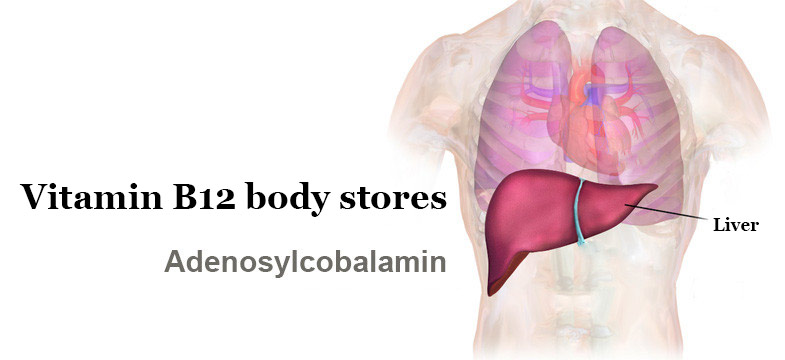The Body’s Vitamin B12 Store: Necessity or Luxury?
Our bodies store a greater amount of vitamin B12 than that of any other vitamin: between 2000-4000 µg, the majority of which is found in the liver (1-4). Theoretically, the body could function on a minimum provision of 1 µg per day for up to 10 years. This is one reason why the serious effects of vitamin B12 deficiency can take several years to emerge.
A consensus is yet to be reached regarding the optimal storage amount and biological relevance regarding the body’s reserves. Some argue that the body stores B12 to ensure that irregular intake does not have a negative impact on health, indicating just how important it is for us. It could also be due to the fact that meat was less common in the diets of our ancestors.
Other researchers consider it to be a luxury phenomenon (5): due to excessive meat consumption in industrialised countries the liver is rich in vitamin B12. The fact that the body breaks down and excretes very high quantities of B12 also supports this view.
There are probably elements of truth in both theories. While the body appears to naturally build up a large store of B12, its level in industrialised countries today could far exceed the natural requirement. Some experts believe that the absolute minimum amount of stored vitamin B12 should be 500 µg; anything under this is deemed critically low (6).
The Structure of the Body’s Vitamin B12 Storage System
There are three natural forms of vitamin B12 found in the body: adenosylcobalamin, methylcobalamin and hydroxocobalamin. The following values are the average B12 levels found in the body’s reserves (7):
- Liver: 2000 µg of adenosylcobalamin
- Cell plasma (total): 35 µg of methylcobalamin and 430 µg of hydroxocobalamin
If vitamin B12 stored in the liver is required, the adenosyl group separates to transport cobalamin to the cells where methyl and hydroxocobalamin are formed. Methylcobalamin levels are always lower, not because there is a higher demand, but because once formed it is used immediately. In contrast, hydroxocobalamin spends longer in the body.
Depletion of Vitamin B12 Reserves
The first signs of vitamin B12 deficiency resulting from a lack of B12-rich foods in the diet will start to become apparent after 2-8 years on average (8-9). Vegetarian children and infants with mothers who are B12 deficient (10) are unable to develop a bodily reserve and so deficiency can occur very early in life.
Every day around 0.1% of our bodily B12 reserve is lost via the urine, regardless of how much is stored. This means that the higher the level of the reserves, the higher the amount of B12 excreted (11).
Today it is assumed that the stored amount should be between 1000-2000 µg ideally, to ensure coverage during times of increased need, such as when gastrointestinal illnesses occur.
Consequences of Low Vitamin B12 Stores
Levels between 500-1000 µg in the liver are considered to have no recognisable health benefits. A measurement within this range means that whilst the capacity is not saturated, bodily functions are not impaired.
The implications of low B12 stores are quite serious. In the case of persistently low levels, serious deficiency symptoms can manifest quite quickly.
To avoid this, it is recommended that the daily B12 intake also contributes towards topping up the body’s store. This consideration has already been accounted for in many officially-stated RDAs (Recommended Daily Allowances). Depending on the country, the RDA lies between 2.4-3 µg to cover the daily requirement and provide for the vitamin B12 store.
Even so, most vitamin experts doubt that this amount is actually sufficient. See here our article: Vitamin B12 Daily Requirement
Replenishing Vitamin B12 Reserves
The recommended daily dose assumes that there is a sufficient amount of stored B12 in the first place. Vitamin B12 deficiency is usually only noticed once reserves have been fully depleted after some time, and this daily dosage is not sufficient to replenish the body’s depleted store.
Often, when a deficiency is present, an initial high dose is administered to refill B12 reserves. To this end, the use of oral vitamin B12 supplements such as vitamin B12 pills, capsules and drops has a limited effect. Even a really high oral dose of 1000 µg would only deliver at most 13 µg.
To obtain 2000 µg in this way would take over six months. As a result, a vitamin B12 injection is often used here, where absorption is equal to the amount of active ingredient administered; typically up to 700 µg. The body stores are thus quickly replenished to optimal levels after just a few injections.
For a regular supply of vitamin B12, oral supplements are more appropriate, as speed is not a priority. With the correct vitamin B12 dosage, the daily requirement can be covered and the body stores sufficiently topped up. Supplementation must remain regular for a prolonged period of time, otherwise deficiency can quickly return.
Vitamin B12 Therapy and the Body’s Store
Today the maintenance of a healthy store of vitamin B12 is considered important and should be taken into account in vitamin B12 deficiency treatment. With the use of oral supplements, and when vitamin B12 intake has been low or inconsistent for some time, an ample dosage of 500 µg is advised for several months before it is lowered. A mixture of methylcobalamin and hydroxocobalamin are optimal, as the latter form is stored most effectively.
Sources
- Reizenstein PS, Ek G, Matthews CME. Vitamin B,2 kinetics in man. Implications of total-body B12 deter- minations, human requirements, and normal and pathological cellular B,2 uptake. Phys Med Biol 1966;2:295-306.
- Hall CA. Long-term excretion of 57Co.vitamin B12 and turnoverwith plasma. AmJClinNutr 1964;14:156- 62.
- Adams iF, Boddy K, Douglas AS. Interrelation of serum vitamin B2, total body vitamin B12, peripheral blood morphology and the nature of erythropoiesis. Br J Haematol 1972:23:297-305.
- Linnell JC, Hofibrand AV, Hussein HAA, Wise LI, Matthews DM. Tissue distribution ofcoenzyme and other forms of vitamin B32 in control subjects and patients with pernicious anemia. Gin Sci Mol Med l974;46: 163-72.
- Donald S. McLaren. The luxus vitamins-A and B12 Am. J. Clin. Nutr. 34 : 161 1-1616, 1981.
- GRASBEcK, R. Calculations on vitamin B12 turnover in man. Scandinav. J. C/in. & Lab. Invest., 11:250, 1959.
- Linnell JC. The fate of cobalamins in vivo. In: Babior BM, ed. Cobalamin: biochemistry and pathophysiology. New York: Wiley-Interscience. 1975: 287-333.
- Chanarin I. The megaloblastic anaemias. 2nd ed. Oxford: Blackwell, 1979.
- Maclean, L. D. and Sunbert, R. D. Incidence of megaloblastic anemia after total gastrectomy. New England J. Med., 254: 885, 1956.
- Dorothy K. Grange, Jonathan L. Finlay. Nutritional Vitamin B12 Deficiency in a Breastfed Infant Following Maternal Gastric Bypass. Pediatric Hematology-Oncology 1994 11:3, 311-318
- Heyssel, R. M., et al. Vitamin B12 Turnover in Man The Assimulation of Vitamin B12 from Natural Foodstuff by Man and Estimates of Minimal Daily Dietary Requirements. The American journal of clinical nutrition, 1966, 18. Jg., Nr. 3, p176-184.


